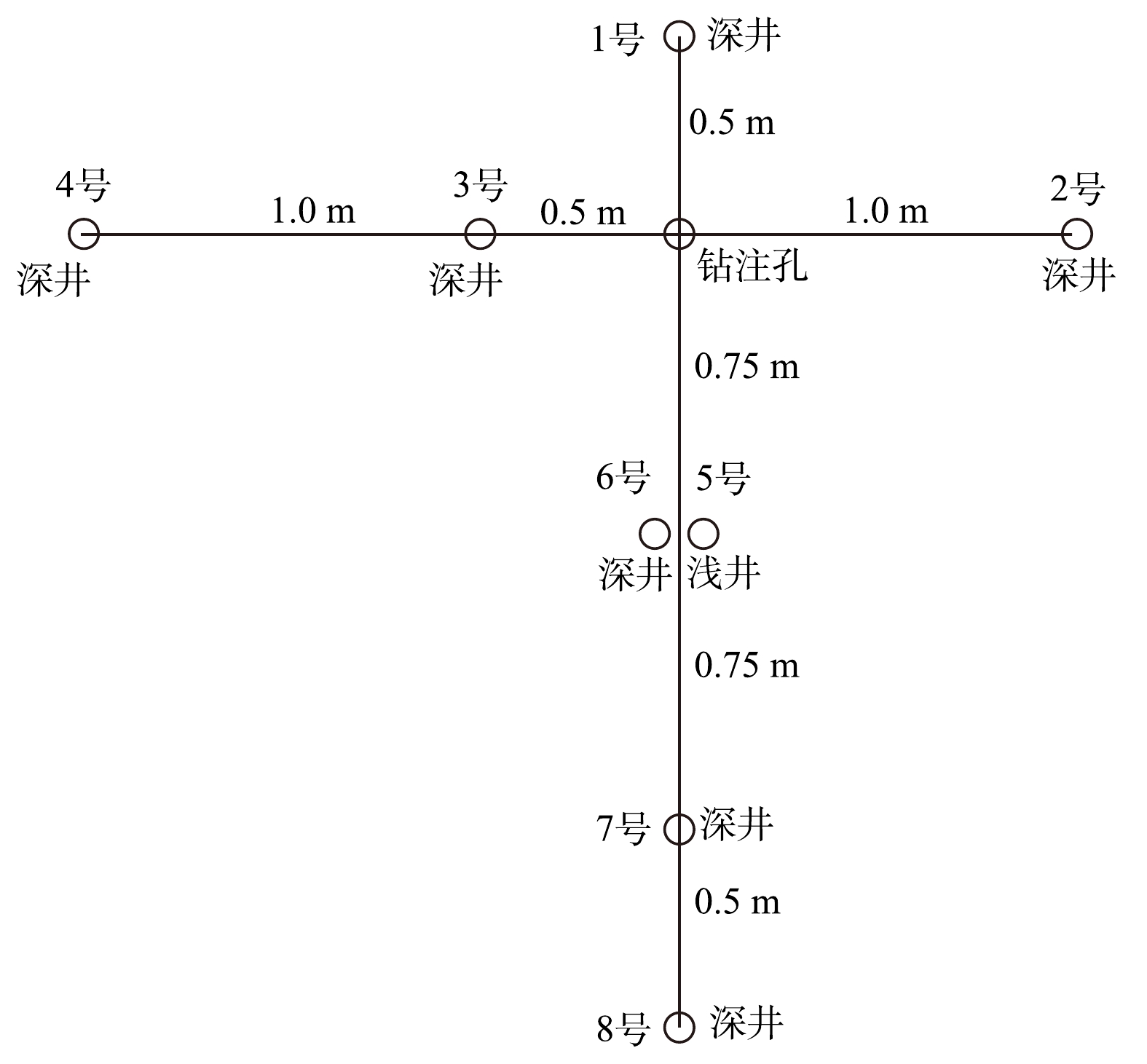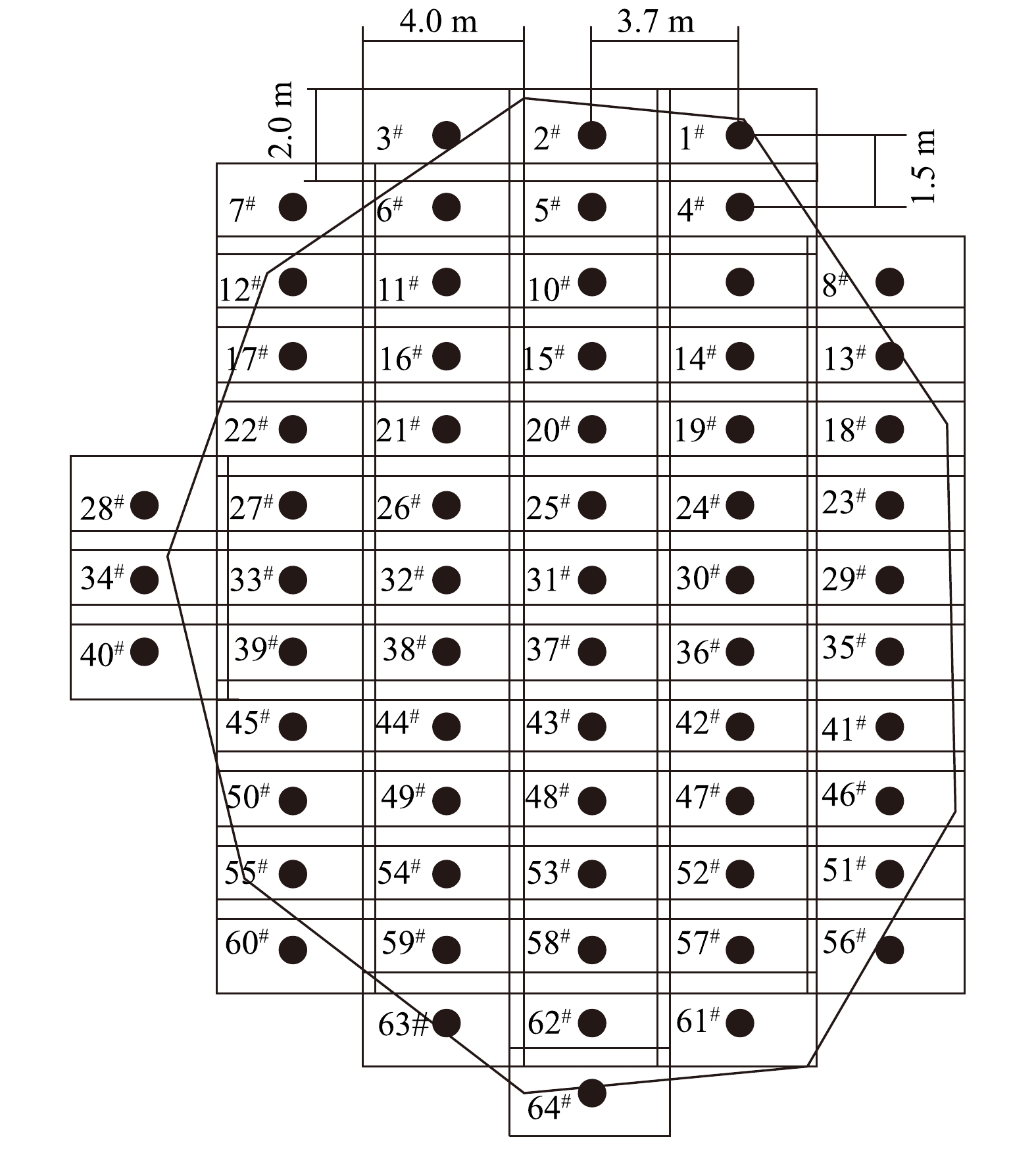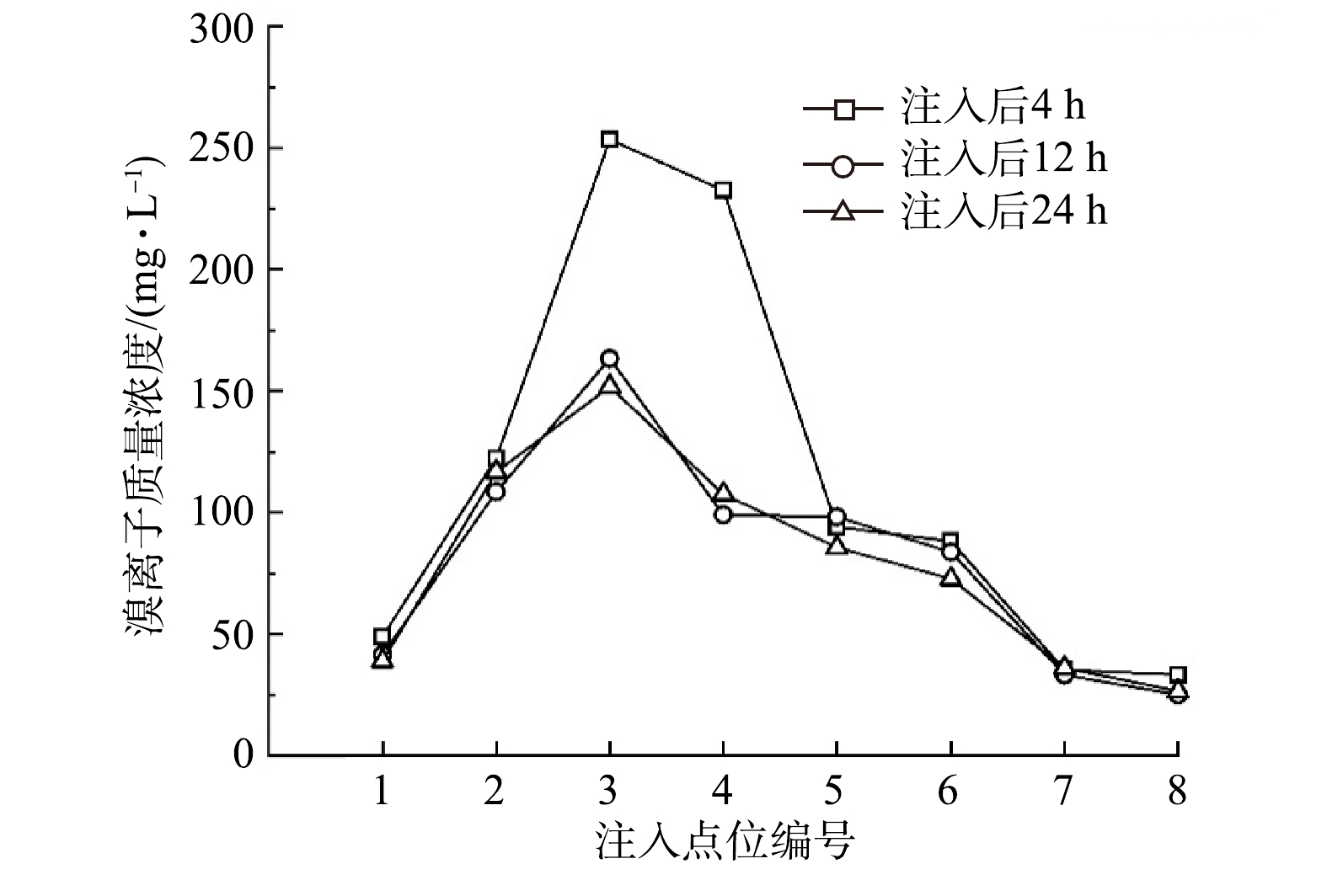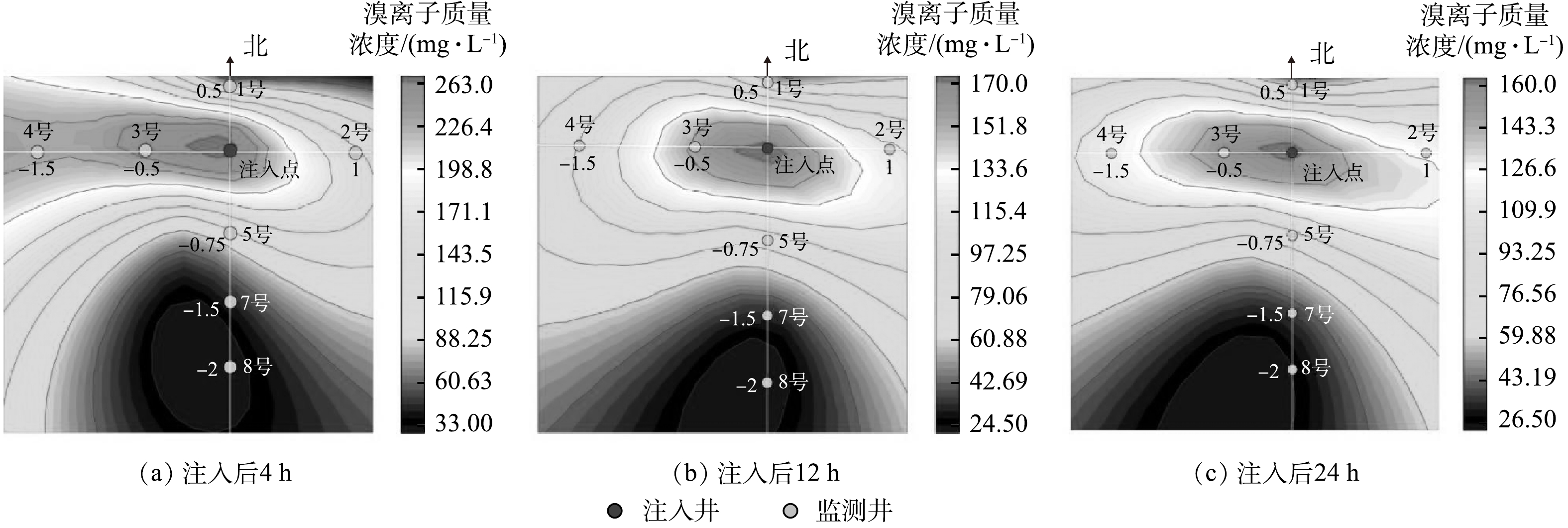-
地下水是人类赖以生存和持续发展的物质基础与战略资源。保护地下水环境,对经济社会发展及生态环境安全都具有重要意义[1-3]。但随着我国经济社会的快速发展,污水废水的无序排放、工业生产过程的跑冒滴漏、化肥农药的过度施用等使得地下水污染问题日益突出[4-6]。2019年生态环境公报显示,全国10 168个地下水水质监测点,IV类占比66.9%,V类占比18.8%,地下水质量不容乐观[7]。
因此,开发高效的地下水污染修复技术成为了一个重要的研究课题。目前,常用地下水修复技术包括抽出-处理技术、渗透性反应墙技术、原位化学氧化/还原技术等[8-10]。其中,原位化学氧化技术具有场地适应性强、修复彻底、处理污染物种类较多、处理时间较短、成本相对低廉等显著优势,在地下水修复中得到广泛运用[11-13]。原位化学氧化技术是指借用一定的技术设备将固、液或气态氧化药剂注入到地下水中,利用氧化剂的强氧化性,使污染物质氧化分解,转变成低毒或者无毒物质的方法[14],其修复效果取决于污染含水层深度、药剂在饱和层介质中的迁移扩散能力,以及药剂与污染物的接触和反应效率等[15-17],其中注入方式的选择对药剂在饱和层介质中的迁移扩散能力具有重要影响[18]。影响半径是反映药剂迁移扩散情况的直观参数,大量研究者们希望通过理论计算的方式得到单个注射井的影响半径,但目前仍无统一定论。Friedrich对美国数百个原位化学氧化技术修复土壤和地下水的相关资料进行了统计,结果显示,氧化剂的影响半径为0.5~15 m,有效作用半径为0.5~7.5 m[19]。
目前,有关原位化学氧化技术的研究多集中于氧化剂活化方式[20-22]、缓释型药剂开发[23-24]、监测方法[25-26]、氧化机理[27-28]等基础性研究工作,而对于注入技术的探索较少。当前地下水修复原位注入技术主要包括直压式高压注射法、注射井法、高压旋喷注射法、Geoprobe技术、电动化学注浆、深层搅拌等[29]。大量研究及实践表明,现有的原位注入技术普遍存在钻注不同步、注入效率差、作用深度有限、模块化程度低等问题[30]。
本研究针对某退役化工厂地下水中的有机污染物氯苯,采用本研究团队自主开发的连续管式原位注入化学氧化技术开展中试实验,研究药剂影响半径并验证设备可靠性和修复效果,以期为该项技术的工程化推广提供参考。
-
本研究以北方某化工厂污染地块修复为案例。该化工厂始建于20世纪90年代,占地面积约4.51×105 m2,经营期间主要从事香精香料生产,2008年已全部停产搬迁。该地块土地利用规划为区域公用设施用地(H3)中的环卫设施用地。实验区位于该地块内,根据场地环境详细调查报告,实验区所在地块存在地下水污染,主要污染物为氯苯,质量浓度在600~1 200 μg·L−1,污染深度为2.10~16.00 m,污染范围为443 m2,修复目标值为400 μg·L−1。
地质勘察结果表明,该地块地质结构按成因年代可分为5层:1)人工填土层(Qml),主要由杂填土和素填土组成;2)第Ⅰ陆相层(Q43al),主要由粉质黏土、粉土组成;3)第Ⅰ海相层(Q42m),主要由粉质黏土、粉土组成;4)全新统下组沼泽相沉积层(Q41h),由粉质黏土组成;5)全新统下组河床-河漫滩相沉积层(Q41al),主要由粉土、粉质黏土组成。
勘测期间,实验区域地下水埋深2~16 m,附近咸水含水层底界深度约120 m。该区域潜水含水层渗透性较差,地下水径流缓慢。含水层岩性主要为黏土、粉质黏土、粉土;包气带主要为人工填土、粉质黏土和粉土;微承压含水层主要为粉土层,其隔水顶板为粉质黏土层。潜水水位一般年变幅在1.00~2.00 m;包气带垂向渗透系数平均为0.054 m·d−1;潜水含水层渗透系数取值为0.19 m·d−1。
-
本实验采用自主开发的连续管式原位注入化学氧化技术。连续管式原位注入系统主要由自动溶配药模块、连续管注入模块和自动控制集成模块3个模块组成。自动溶配药模块主要包含药剂储存槽(储存固体药剂)、干粉输送机、自动定量配药系统、液体溶药箱(储存液态药剂)、高压柱塞泵及其泵控系统、清水箱等;连续管注入模块主要包含滚筒、注入头、连续管、喷嘴及液压动力系统等;自动控制集成模块主要包含液压控制系统、仪器仪表、传感系统、信号处理系统和操作室等。
设备工作流程为:首先,通过喷嘴喷射出的高压水射流持续破碎、切削土壤,被破碎和切削下来的土壤被泥浆返浆及时带出地面,从而快速形成孔眼,连续管在注入头的给进力作用下沿孔眼不断下钻,从而完成钻进过程;然后,当钻进深度达到设计要求后,通过投珠的方式,使垂向的高压水射流转换为水平方向的高压水射流;同时,在水平方向高压注射过程中,水射流采用药剂溶液,此时控制干粉(固体)输送机和定量泵进行定量输送药剂。示意图如图1所示。
-
实验开始前,对设备各模块及系统参数设置等进行检查,然后,分别在水射流压力为20、15、10、5和3 MPa的情况下开展钻进实验,钻进实验现场如图2所示。实验区地下水中主要目标污染物为氯苯。综合考虑工程施工的安全性、药剂自身氧化能力及应用便利性,本实验采用过硫酸盐作为氧化剂,液碱作为活化剂,配成溶液状态后通过连续管式原位注入装备进行地下水修复。通过小试实验结果,并结合现场施工投加便利性和工程经验,拟定过硫酸钠药剂投加比为1%(质量分数),过硫酸钠药剂中过硫酸钠和30%液碱(活化剂)的质量比为2∶1。
-
1)监测井建设。在注入点周围共设置8口监测井,其中7口深井,1口浅井。深井为地下16.50 m,浅井为地下8.50 m。井套管采用PVC材质的割缝管,口径为80 mm。监测井距离钻注孔0.5~2 m。具体井位布设见图3。
监测井施工采用锤击式桩机成井,成井孔径为200 mm;成井后下入直径80 mm的UPVC割缝管,各割缝管留有500 mm的沉淀段,在割缝段外包有40目不锈钢筛网;然后,用石英砂、黏土填充割缝管与成井之间的环型孔隙,其中,石英砂从井底往上填充2~4 m,再用黏土进行封井;最后,进行洗井,完成监测井建设施工。
2)示踪实验方法。本实验采用溴化钠作为示踪剂,进行影响半径测试。钻注孔深度为16 m,溴化钠溶液注射速率约为80 L·min−1,压力约为20 MPa,连续管向上的运行速度约为0.10 m·min−1。共投入37 kg溴化钠与3 t清水进行溶配,注入实验区。经前期调查检测,实验区溴离子背景值为0,所以在一定时间内,当某个点位明显可检测到溴离子,则可认为该点位在药剂影响半径之内。
采用贝勒管进行取样,每次取样前均进行洗井工作。共开展3次采样,第1次采样时间为药剂注入后4 h、第2次采样时间为注入后12 h、第3次采样时间为注入后24 h。
采用便携式多参数测量仪对溴离子溶度进行检测。正式检测前,需对仪器进行标定。每个样品检测后,都需用清水清洗仪器探头,直到仪器读数为0并稳定为止。
-
1)注入点位布设。根据实验区水文地质条件及药剂影响半径实验(影响半径取2 m),决定采用长方形布点方式对污染区域进行全覆盖。长方形长4 m、宽2 m,注入点位于长方形的中心,南-北行距1.50 m,东-西列距3.70 m,实验区共布设64个注入点,注入井深度16 m。注入点位布设见图4。
2)单孔注入量。结合小试及工程经验,以区域内污染地下水总方量、药剂投加比、布点数量等共同计算单孔药剂注入量,具体计算公式如式(1)。
式中:Iwell为过硫酸钠单孔注入量,kg;S为污染区域面积,443 m2;H为污染地下水深度,污染区地下水分布范围2.10~16.00 m,则污染地下水深度13.90 m;θ为含水层孔隙度,取0.38;ρ为地下水密度,取1 000 kg·m−3;R为药剂投加比,1%;N为实验区布点数量,64。
单个注入点所需药剂:过硫酸钠365.60 kg,作为活化剂的30%液碱182.80 kg。将过硫酸钠、液碱同清水进行混合溶配作为药剂溶液。溶配设计为:每100 L水中,加入过硫酸钠4.57 kg、30%液碱2.285 kg。
3)原位注入施工。原位药剂注入施工时,按注入点序号从1~64进行,即从西向东、从北向南依次注入,充分利用本实验区水文地质特性,最大程度提高氧化药剂利用率,增强修复效果。
-
实验结果表明,连续管式原位注入设备在水射流压力为3 MPa、流量为27 L·min−1时,在钻进实验区的钻进深度仍可达20 m以上,满足本实验场地钻进深度需求。钻进测试数据详见表1。
为增强氧化药剂在饱和层介质中的横向迁移扩散,保证修复效果,结合前期设备性能测试实验,取连续管式原位注入设备的最大水射流压力20 MPa进行高压水射流横向药剂注入,药剂溶液注射流量为80 L·min−1。结合工程经验,设置连续管向上的运行速度为0.10 m·min−1。
-
1)影响半径分析。监测结果见图5。监测井1~8中均明显检出溴离子存在,这说明实验区药剂影响半径可达2 m。其中,3号监测井(距离注入点0.50 m)注入后4 h浓度最高,达253.60 mg·L−1;8号监测井(距离注入点2 m),注入12 h后溴离子检出浓度最低,为24.90 mg·L−1。
2)药剂扩散趋势分析。采用双线性插值法,对不同时间点实验区内溴离子的浓度变化进行了分析,以揭示实验区药剂扩散趋势。如图6所示,该区域在南-北方向药剂扩散较缓慢,但总体药剂有由北向南扩散的趋势;同时,该区域在东-西方向具有相对的优势通道,药剂更易于向东-西方向扩散,且随着时间推移,药剂有由西向东扩散的趋势。本场地的土壤结构为较为均质的粉粘土层,在横向方向上基本具有各相同性,因此,在本实验场地中药剂扩散趋势受土壤结构差异的影响较小,受地下水流向的影响较大。
实验结果表明,药剂扩散趋势同本场地总体地下水流场的流向基本吻合,地下水流向从东向西,从北向南。只是在本实验区块,东-西方向的地下水流向更加明显。
-
单个注入点开展注入工作时,先使用清水进行高压水射流垂向钻进,清水流量为20~100 L·min−1,压力为3~20 MPa,从地表至地下16 m,连续管向下的钻进速度为0.50~2.00 m·min−1;然后进行投珠作业,完成投珠后采用药剂溶液进行高压水射流横向注入,从地下16 m至地下2.10 m,部分注入点的工艺运行数据见表2。每米注射的药剂溶液剂量为600 L,其中,注射压力约为20 MPa、药剂溶液注射速率约为80 L·min−1、连续管向上的运行速度约为0.10 m·min−1。
-
实验区内共设有2口监测井,1号监测井为地下14 m的深井,2号监测井为地下4 m的浅井。注入完成并经30 d的药剂反应期后,在工程监理人员监督下取样送第三方检测机构进行检验,检验结果见表3。2口监测井中目标污染物氯苯的质量浓度均达到了修复目标值以下(400 μg·L−1)。其中,深井中地下水氯苯的质量浓度未达到检测限,浅井中地下水氯苯质量浓度为1.30 μg·L−1。
-
1)在本实验条件下,连续管式原位注入技术的药剂影响半径可达2.00 m。药剂在实验区的扩散趋势主要受地下水流向影响,药剂扩散梯度与场地地下水流场的流向吻合。
2)经连续管式原位注入化学氧化处理30 d后,实验区地下水中目标污染物氯苯的质量浓度均低于修复目标值(400 μg·L−1),这进一步证明原位注入药剂在实验区地层中的有效影响半径达到了2.00 m。
连续管式原位注入化学氧化技术对某有机污染场地地下水的修复效果
Pilot scale study on groundwater remediation in an organic contaminated site by coiled tubing in-situ injection chemical oxidation technique
-
摘要: 针对传统地下水原位注入化学氧化技术存在注入深度浅、效率低等问题,采用连续管和高压水射流技术实现地下水原位修复药剂钻注一体化和水射流钻进,以提高效率和深层修复。以某退役化工厂地下水中的氯苯为目标污染物,基于自主开发的连续管式原位注入化学氧化技术开展了中试规模的实验研究,基于现场实验确定原位注入药剂影响半径并评估了修复效果。结果表明,药剂影响半径可达2 m,且药剂扩散趋势与场地总体地下水流场的流向基本吻合;经原位化学氧化处理后,实验区地下水中氯苯检测质量浓度低于400 μg·L−1,即采用连续管式原位注入化学氧化技术实现了实验区地下水中氯苯的有效去除。本研究可为连续管注入技术在地下水原位修复中的应用提供参考。Abstract: In view of the problems of shallow injection depth and low efficiency of traditional in-situ groundwater chemical oxidation technology, coiled tubing and high-pressure water jet technology were used to realize the integration of in-situ groundwater remediation drilling and water jet drilling, so as to improve efficiency and deep groundwater remediation. Taking the chlorobenzene in the groundwater of a decompensated chemical plant as the target pollutant, a pilot-scale test was carried out based on the self-developed coiled tubing in-situ injection chemical oxidation technology, and field tests were conducted to determine the influence radius and remediation effect of the in-situ injection agent. The results showed that the influence radius of the agent was up to 2 m, and the diffusion trend of the agent was basically consistent with the flow direction of the overall groundwater flow field of the site. After the in situ chemical oxidation treatment, the detection concentration of chlorobenzene in the groundwater of the test area was lower than 400 μg·L−1, that means the coiled tubing in-situ injection chemical oxidation technology was used to effectively remove chlorobenzene in the groundwater of the test area. This study can provide theoretical reference for the application of coiled tubing injection technology in in-situ remediation of groundwater.
-

-
表 1 设备钻进实验数据
Table 1. Drilling test data of equipment
实验序号 压力/MPa 流量/(L·min−1) 水射流理论喷速/(m·s−1) 1 20.09 79 200 2 15.21 69 174 3 9.83 56 140 4 4.98 40 100 5 3.12 33 77 表 2 部分点位工艺运行数据
Table 2. Operation data of some in-situ injection points
注入点
序号钻进压力/MPa 钻进清水耗量/L 钻进时间/min 药剂注射压力/MPa 药剂溶液注入量/L 注入时间/min 1 20.93 795 10 20.90 8 206 104 4 19.40 830 10 22.28 7 860 97 7 13.69 748 11 21.14 8 340 105 10 15.48 700 10 21.85 7 820 95 13 9.11 660 12 22.84 8 814 110 16 4.38 451 11 22.13 8 592 106 19 4.49 546 14 18.59 8 560 112 22 5.82 418 11 19.14 8 092 101 25 5.31 468 12 21.81 8 660 113 28 6.33 451 11 20.79 8 506 107 31 4.66 520 13 21.02 7 860 97 34 5.41 494 13 21.94 7 798 94 37 4.88 533 13 19.22 8 820 110 40 5.90 462 11 18.13 9 112 128 43 6.14 560 14 21.64 8 610 108 46 5.25 451 11 21.10 7 614 94 49 3.90 588 14 20.06 8 427 107 52 4.88 588 14 20.12 7 800 100 55 7.00 507 13 21.50 7 454 93 58 4.24 546 13 22.77 7 300 90 61 4.38 574 14 21.91 9 382 120 64 6.72 480 12 21.93 8 018 99 表 3 修复前后目标污染物质量浓度变化情况
Table 3. The concentration of target pollutants after remediation
监测井编号 井深/m 氯苯质量浓度/(μg·L−1) 修复前最高值 修复后最高值 1 14.00 1 200 未检出 2 4.00 950 1.30 注:修复目标值400 μg·L−1。 -
[1] 薛禹群, 张幼宽. 地下水污染防治在我国水体污染控制与治理中的双重意义[J]. 环境科学学报, 2009, 29(3): 474-481. doi: 10.3321/j.issn:0253-2468.2009.03.002 [2] 吕倩, 魏洁云. 中国地下水污染现状及治理[J]. 生态经济, 2016, 32(10): 4. [3] NEWELL C J, ADAMSON D T, KULKARNI P R, et al. Comparing PFAS to other groundwater contaminants: Implications for remediation[J]. Remediation Journal, 2020, 30(3): 7-26. doi: 10.1002/rem.21645 [4] 丁嘉琰. 城市地下水污染现状及防治技术研究[J]. 资源节约与环保, 2020(11): 47-48. doi: 10.3969/j.issn.1673-2251.2020.11.029 [5] 姚德俊, 岳昌盛, 吕建国, 等. 我国工业场地污染地下水修复技术研究进展[J]. 现代化工, 2020, 40(12): 45-49. [6] LI Z, SUN Y, YANG Y, et al. Biochar-supported nanoscale zero-valent iron as an efficient catalyst for organic degradation in groundwater[J]. Journal of Hazardous Materials, 2020, 383: 121240.1-121240.9. [7] 2019年中国生态环境状况公报[EB/OL]. [2020-06-02]. https://www.mee.gov.cn/hjzl/sthjzk/zghjzkgb/202006/P020200602509464172096.pdf. [8] 陈敏. 地下水污染修复技术综述[J]. 云南化工, 2020, 47(11): 12-14. doi: 10.3969/j.issn.1004-275X.2020.11.05 [9] 蒲生彦, 侯国庆, 吕雪, 等. 过氧化钙缓释技术在地下水污染修复中的应用研究[J]. 工业水处理, 2020, 40(8): 1-6. [10] YONG S O, JORG R, DEYI H, et al. Soil and Groundwater Remediation Technologies: A Practical Guide[M]. CRC Press, 2020. [11] 吴金红, 吴志鹏. 高压旋喷注射法在城市石油烃污染场地修复中的实践应用[J]. 绿色科技, 2018(12): 93-96. [12] CHEN L W, HU X X, CAI T M. Degradation of triclosan in soils by thermally activated persulfate under conditions representative of in situ chemical oxidation (ISCO)[J]. Chemical Engineering Journal, 2019, 369: 344-352. doi: 10.1016/j.cej.2019.03.084 [13] UNGTAE K, JACK C P, ROBERT C B. Stochastic cost-optimization and risk assessment of in situ chemical oxidation for dense non-aqueous phase liquid (DNAPL) source remediation[J]. Stochastic Environmental Research and Risk Assessment, 2019, 33(1): 73-89. doi: 10.1007/s00477-018-1633-y [14] 崔朋, 刘骁勇, 刘敏, 等. 原位化学氧化技术在苯酚类污染场地修复中的应用[J]. 山东化工, 2020, 49(9): 251-253. [15] 宛召. 高压旋喷工艺在上海某污染场地修复中的应用研究[D]. 长春: 吉林大学, 2017. [16] MANOJ P. R, DASOM O, CHUNG-SEOP L, et al. In situ chemical oxidation of contaminated groundwater using a sulfidized nanoscale zerovalent iron-persulfate system: Insights from a box-type study[J]. Chemosphere, 2020, 257: 127117. doi: 10.1016/j.chemosphere.2020.127117 [17] YANG X Y, CAI J S, WANG X N, et al. A bimetallic Fe-Mn oxide-activated oxone for in situ chemical oxidation ISCO of trichloroethylene in groundwater: Efficiency, sustained activity and mechanism investigation[J]. Environmental Science & Technology, 2020, 54(6): 3714-3724. [18] 张超. 地下水中1, 2, 4-TCB污染的原位化学氧化修复技术实验研究[D]. 南京: 南京大学, 2018. [19] FRIEDRICH J K. Critical analysis of the field-scale application of in situ chemical oxidation for the remediation of contaminated groundwater[D]. Colorado: Colorado School of Mines, 2008. [20] LIU X X, YUAN S H, ZHANG P. Reduced nontronite-activated H2O2 for contaminants degradation: The beneficial role of clayed fractions in ISCO treatments[J]. Journal of Hazardous Materials, 2020, 386: 121945. [21] ALANNAH T, NICK Z, STEPHEN P M. In-situ chemical oxidation of chlorendic acid by persulfate: Elucidation of the roles of adsorption and oxidation on chlorendic acid removal[J]. Water Research, 2019, 162: 78-86. doi: 10.1016/j.watres.2019.06.061 [22] YAN N, ZHONG H, BRUSSEAU M L. The natural activation ability of subsurface media to promote in-situ chemical oxidation of 1, 4-dioxane[J]. Water Research, 2019, 149: 386-393. doi: 10.1016/j.watres.2018.11.028 [23] 蒲生彦, 陈文英, 王宇, 等. 可控缓释技术在地下水原位修复中的应用研究进展[J]. 环境化学, 2020, 39(8): 2237-2244. [24] PETER T P, ROBERTO A, FEDERICO P, et al. Sustained release of persulfate from inert inorganic materials for groundwater remediation[J]. Chemosphere, 2020, 259: 127508. doi: 10.1016/j.chemosphere.2020.127508 [25] NAIMA A K, KENNETH C C. Natural attenuation method for contaminant remediation reagent delivery assessment for in situ chemical oxidation using aqueous ozone[J]. Chemosphere, 2020, 247: 125848. [26] 姜勇, 徐刚, 杨洁, 等. 高密度电法在原位修复土壤过程中的监控研究[J]. 环境监测管理与技术, 2020, 32(6): 18-22. doi: 10.3969/j.issn.1006-2009.2020.06.005 [27] ZENG H B, ZHAO X, ZHAO F P, et al. Oxidation of 2, 4-dichlorophenol in saline water by unactivated peroxymonosulfate: Mechanism, kinetics and implication for in situ chemical oxidation[J]. Science of the Total Environment, 2020, 728: 138826. doi: 10.1016/j.scitotenv.2020.138826 [28] MASOUD A, HARIHAR R. Transport with bimolecular reactions in a fracture‐matrix system: Analytical solutions with applications to in situ chemical oxidation[J]. Water Resources Research, 2019, 55(5): 3904-3924. doi: 10.1029/2019WR024762 [29] 陈素云, 王慧玲, 张靖婷, 等. 探讨原位化学氧化法氧化剂分散技术[J]. 环境与发展, 2018, 30(1): 113-114. [30] 冯超, 王瑜, 王志乔, 等. 地下水原位修复材料钻进注入技术现状调研[C]//中国地质学会. 第二十届全国探矿工程(岩土钻掘工程)学术交流年会论文集. 中国地质学会: 中国地质学会探矿工程专业委员会, 2019: 9 -



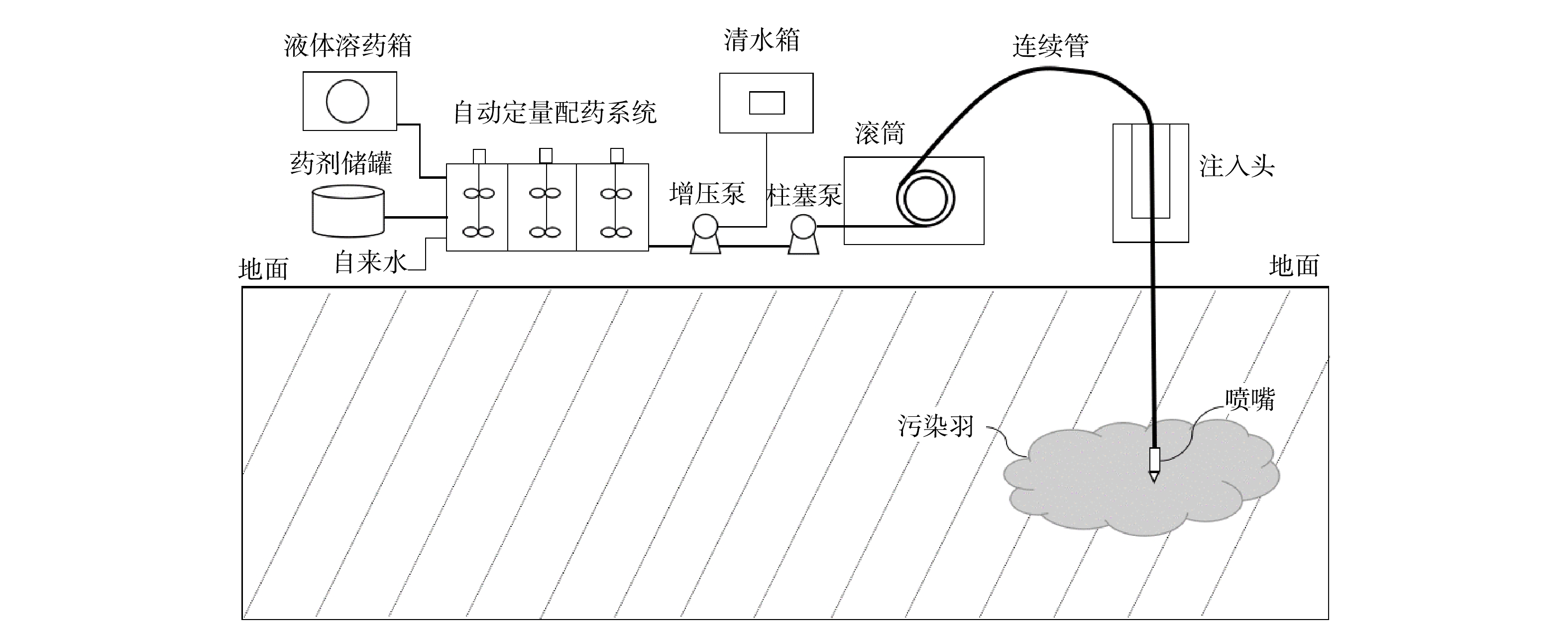
 下载:
下载:

